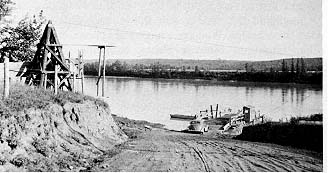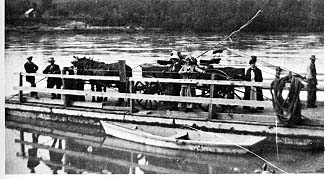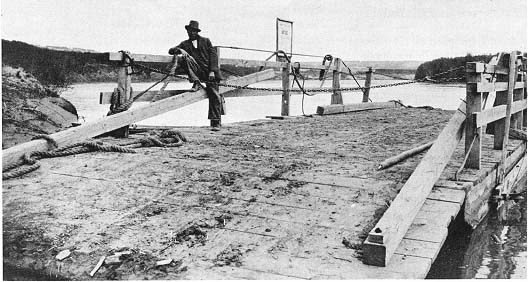North Saskatchewan River SE25-56-7-4
Charlie Hood had a general store at Elk Point and also operated a scow across the river to assist settlers coming into the area after 1909.
Although the name Elk Point was established in 1909, the crossing, in the vicinity of the old fur trading posts of Buckingham House and Fort
George, was known locally as "Hood's Crossing" for many years.

Approach to Elk Point Ferry
The government built a ferry for this crossing in 1913 and floated it downriver from Edmonton, but as there were no accompanying
barges to guide it, it floated right past the crossing and was used elsewhere. As a result, another ferry had to be built for Elk Point. As
the area developed and more settlers arrived, it became a very busy crossing. Stock days saw waiting line-ups over a mile long, with
animals squealing and bellowing their protests on their way to the stockyards north of the river. In the evenings, wagons lined up to
return on the ferry, laden with goods and supplies purchased with the stock cheques. Every fall, too, there was a desperate rush to get the
harvested grain across on the hardworking little ferry to the elevators before the river ice started to form.

Elk Point Ferry in operation 1914

Charlie Magnusson on ferry in 1913
Sometime in the 1930s, ferryman Alf Monkman and Dr. F. G. Miller, the local doctor, rigged up a platform known as the "Jigger," to
be used in emergencies during spring and fall when the ferry could not be used. If Dr. Miller had to cross the river on an emergency call, he
and Alf would crouch low on the "jigger" as it sped down the cable to the middle of the river, then stand up and haul themselves up the other
half of the cable. While the doctor visited his patient, Alf would build a fire and await the doctor's return, both repeating the crossing in the
same way. Sometimes the doctor would be called out again the same night, and he and Alf would do the same thing all over again!
The government built and installed a larger "cage" for emergency crossings about 1935 - a much safer way of crossing, known locally
as the "go-devil." This was used to transport mail and supplies and could also be used by passengers. About 1939, the "go-devil" loaded
with a group of local boys fell about twenty feet on to the river ice, but fortunately pone of the passengers was hurt.
Excerpt from Haestie, Elizabeth Ferries and Ferrymen in Alberta, Glenbow Museum 1986
Steve Andrisak https://elkpointhistory.ca/river-crossings-over-north-saskatchewan-river
Reflections info https://elkpointhistory.ca/elk-point-ferries
Charlie Magnusson https://elkpointhistory.ca/families/pioneer-families-arriving-1920/magnusson-charlie
Ole Martin Jacobson https://elkpointhistory.ca/families/pioneer-families-arriving-1920/jacobson-ole-martin



